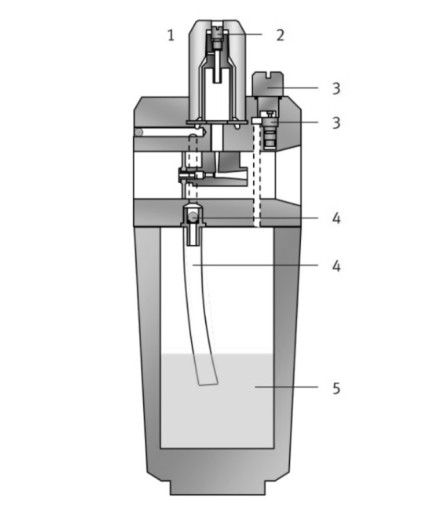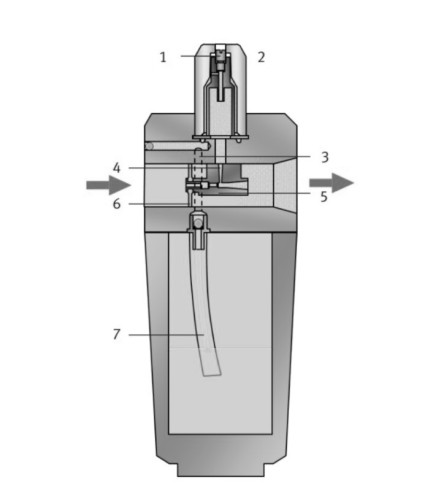Compressed air lubricators
A lubricator is a device located downstream of the air compressor. It usually consists of a small reservoir with a supply of lubricating oil and a dosing mechanism that dispenses a specific amount of oil into the air stream. The oil reduces the wear of highly stressed pneumatic drives and prevents the formation of rust and moisture. The Festo range not only includes individual accessories such as lubricators, but also complete service unit combinations. Depending on the area of application, they also offer other components for a service unit such as soft-start valves, filter regulators, filters, on/off valves and branching modules.
Layout and function
Oil is pumped from a reservoir and released into the flowing air droplet by droplet. The desired quantity of oil which is to be released into the air during a specified period of time can be selected with an adjusting screw at the top of the lubricator. A sight glass is installed within the stream of air for monitoring purposes.
The pressurised oil reservoir must be exhausted in order to refill it with oil. A special valve is included in the lubricator to this end, which exhausts the lubricator automatically when it is opened (design varies from series to series).

- Detail of a lubricator
- 1 Oil sight glass
- 2 Regulating screw
- 3 Exhaust screw with valve
- 4 Tubing with non-return valve
- 5 Oil reservoir
Prevailing working pressure in the oil reservoir forces oil through the tube. Initially, the oil advances into the oil sight glass via a channel, where it passes through a restrictor at the same time which doses the oil. Drop by drop, it then advances into the venturi nozzle's suction channel, which atomises it into the compressed air.
Air flowing through the lubricator is fed through a pneumatic distributor prior to lubrication. The distributor consists of a specially shaped rubber diaphragm, whose shape has a corresponding influence on flow.
Interaction between the venturi nozzle and the distributor's shape-dependent aerodynamic drag assures lubrication which is proportional to the flow rate. Otherwise, for example, the air would be over-lubricated in the case of minimal flow rates.

- Detail of a lubricator
- 1 Regulating screw
2 Oil sight glass
3 Channel
4 Suction end of the venturi nozzle
5 Venturi nozzle
6 Pneumatic distributor
7 Suction tube
Types of oil
Oil quality is broken down into ISO classes which are defined in the ISO 3448 standard. Types of oil: Festo special oil, ARAL Vitam GF 32, BP Energol HLP 32, ESSO Nuto H 32, Mobil DTE 24, Shell Tellus Oil DO 32.
cST = centistokes
The centistoke is a unit of measure for the kinematic viscosity of oil. It is specified as m²/s. Kinematic viscosity = dynamic viscosity + density.
Over-lubricated air
If silencer exhaust ports become discoloured, this may indicate that there’s too much oil in the air.
What to look for in a compressed air lubricator
It is important to use the correct type of oil for your application, as using the wrong oil can lead to problems such as reduced efficiency or even damage to the pneumatic components. It is also important to maintain and properly fill the lubricator, as a lack of lubrication can lead to premature wear and failure of the components.
Service unit combination, MS series
With the MS service unit combinations from Festo, you can prepare every aspect of your compressed air for different applications. The devices are characterised by a wide range of settings, highly functional components and a wide range of services. This means that they can be used individually for simple standard applications as well as for very application-specific solutions with the highest quality requirements. Thanks to the modular design, it is possible to order predefined combinations, individual components, ready-to-install solutions or freely configurable service unit combinations from stock. Depending on the application, these can be made up of filter control valves, lubricators, sensors, dryers, safety functions, flow sensors, on/off valves, branching modules, compressed air assembly valves and filters. The simple connection system saves time when replacing individual modules, which is quick and easy to do without having to dismantle the entire device. Many of the components in the service unit combinations are also UL and ATEX certified.
Possible components for service unit combinations
The following components are possible in service unit combinations of the MS series:
- Filter regulatorMS-LFR: This component combines a filter and pressure regulator. The grade of filtration is 5 or 40 μm.
- Filter regulatorMS-LFR-B: This device also combines a pressure regulator and filter in a polymer housing. Its grade of filtration is also 5 or 40 μm.
- Activated carbon filterMS-LFX: Suitable for removing superfluous and gaseous oil particles.
- Water separatorMS-LWS: This maintenance-free component can remove condensation from compressed air.
- LubricatorMS-LOE: This lubricator adds a finely adjustable amount of oil to the compressed air. The proportion of oil mist relates to the flow rate of the compressed air.
- On/off valveMS-EE-B: This is an electrically operated on/off valve in a polymer housing. It is used for pressurising and exhausting pneumatic systems.
- Membrane air dryerMS-LDM1: This component is a wear-free membrane dryer with internal air consumption.
- Distributor blockMS-FRM-FRZ: This device is an air distributor with 4 connections and half the grid width.
Find out more about the above components and many others for your individual compressed air service unit at Festo. Oil and maintain your pneumatic tools in factory automation with various accessories from Festo. Festo offers the right lubricator and the right technical service unit for every function, every tool, every connection, every pressure regulator and every manufacturer.
Application areas for compressed air lubricators
There are many different applications where a lubricator can be used in a pneumatic system. Here are some examples:
- Textile industry: Pneumatic scissors and sewing machines can be lubricated to reduce friction and wear on the moving parts.
- Transport of materials: Pneumatic conveyors and other equipment for transporting materials can be lubricated with a lubricator to reduce wear and improve efficiency.
- Printing industry: Pneumatic presses and dyeing machines can be lubricated to ensure their long-term efficiency.
- Processing: Pneumatic processing equipment such as ironing and pressing machines can be lubricated with a lubricator to reduce wear.
- Packaging industry: Pneumatic packaging equipment, such as packaging and wrapping machines, can be lubricated to reduce wear and improve efficiency. A lubricator can help to keep these devices running smoothly, reducing the risk of contamination (e.g. in the food industry).